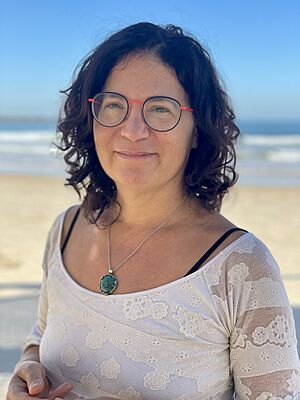Dorit Aharonov facts for kids
Quick facts for kids
Dorit Aharonov
|
|
|---|---|
| דורית אהרונוב | |
 |
|
| Born | 1970 (age 55–56) |
| Education |
|
| Known for | Aharonov–Jones–Landau algorithm Quantum threshold theorem |
| Awards | Krill Prize for Excellence in Scientific Research |
| Scientific career | |
| Fields | Quantum computing |
| Institutions | Hebrew University |
| Thesis | Noisy Quantum Computation (1998) |
| Doctoral advisor | Avi Wigderson Michael Ben-Or |
Dorit Aharonov, born in 1970, is a brilliant computer scientist from Israel. She is an expert in a super cool field called quantum computing. This field explores how we can use the strange rules of quantum physics to build powerful computers.
Contents
About Dorit Aharonov
Dorit was born in Washington, D.C., and grew up in Haifa, a city in Israel. Her father, Dov Aharonov, was a mathematician, and her uncle, Yakir Aharonov, was a physicist. So, science runs in her family!
Her Education
Dorit studied physics at the Weizmann Institute of Science. She then earned her PhD in Computer Science in 1999 from the Hebrew University of Jerusalem. Her PhD paper was about "Noisy Quantum Computation," which sounds complicated but is about how to make quantum computers work even with tiny errors.
After her PhD, she continued her research at Princeton University and the University of California Berkeley. This extra research time, called a "post-doctorate," helps scientists become even bigger experts in their field. She also spent time as a visiting scholar at the Institute for Advanced Study.
Awards and Recognition
Dorit Aharonov has received many awards for her amazing research. In 2005, Nature magazine, a very famous science publication, named her one of the four "most prominent young theorists" in her field. The next year, she won the Krill Prize for excellence in scientific research.
In 2010, she was invited to speak at the International Congress of Mathematicians in Hyderabad, India. This is a huge honor, showing how important her work is in the world of mathematics and computer science. In 2014, she received the Michael Bruno Memorial Award. Most recently, in 2024, she was chosen to be a member of the National Academy of Sciences, which is a very high honor for scientists in the United States.
What Dorit Aharonov Researches
Dorit Aharonov's main work is in quantum information processes. This means she studies how information can be stored and processed using the rules of quantum mechanics. It's like trying to figure out how to build and use computers that are completely different from the ones we have today.
Key Areas of Her Research
- Quantum Algorithms: These are special sets of instructions for quantum computers. Dorit helps figure out how these algorithms can solve problems much faster than regular computers.
- Quantum Cryptography: This is about using quantum rules to create super-secure ways to send secret messages. It's like making unbreakable codes!
- Quantum Error Corrections: Quantum computers are very sensitive. Dorit works on ways to fix mistakes that happen when these computers are working, making them more reliable.
- Quantum Hamiltonian Complexity: This area connects quantum computing to how materials behave at a tiny, quantum level. It helps us understand things like superconductors.
- Understanding Entanglement: Entanglement is a weird quantum phenomenon where two particles are linked, no matter how far apart they are. Dorit studies how this "spooky action at a distance" can be used in quantum computing.
Her research helps us understand the exciting future of computing and how quantum physics can change our world.
See also
 In Spanish: Dorit Aharonov para niños
In Spanish: Dorit Aharonov para niños

